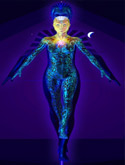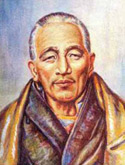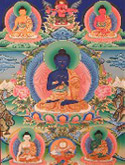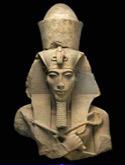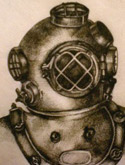Storks and Stars: Astrological Fertility Cycle
Some years ago, Dr. Eugen Jonas, a Czechoslovakian psychiatrist with a penchant for ancient writings, came across a curious sentence in an Assyrian or Babylonian manuscript stating that, “A woman is fertile according to the Moon.” After much brooding and reflection, he began researching lunar cycles and ultimately found that 70-85% of pregnancies occur when the lunar phase is the same as it was at the moment of the woman’s birth. According to Jonas, 15-30% of pregnancies occur during the ovulation phase, thereby making the rhythm method unreliable for those who use it to avoid pregnancy.

When the ovulation cycle and astrological fertility cycle converge, there is a period of extremely high fertility. Jonas believed that many conceptions occur when the two cycles synchronize.
He went on to found an enormous chain of Astro Fertility Centers in Eastern Europe where inexpensive but reliable methods of contraception were sought by many who for religious or economic reasons wanted to use a non-invasive method of birth control.
Used in reverse, the combination of the two cycles makes planned parenthood relatively easy to use also.
Simply stated, there is a greater chance of conception when the lunar phase is the same as at the mother’s birth than by using any other measure of fertility (such as temperature, ovulation, mucus, etc.) For example, if a woman was born when the Moon was full, she will be fertile when the Moon is full. If she was born during the first quarter of the Moon, she will be fertile at that time.
Jonas went on the prove that the sign the Moon is in at the moment of conception determines the sex of the child that will be conceived, again with virtually 100% accuracy. He maintained that twins consisting of one boy and one girl are conceived when the Moon is changing signs. If the Moon is in Aries, Gemini, Leo, Libra, Sagittarius, or Aquarius when the conception occurs, a boy will be born. If it is in Taurus, Cancer, Virgo, Scorpio, Capricorn, or Pisces, a girl will be born.
Warning: It is necessary to allow time for the sperm to travel to reach the egg. Jonas allowed 12 hours. Conception occurs when the sperm impregnates the egg and it is this moment that is used to determine the sex of the child. Ergo, if the exact phase of the Moon occurs at 10:00 am, sexual relations (or artificial insemination) must occur the night before so that some viable sperm are present where they need to be at the exact moment of maximum fertility.
The Monastic Moon: Virgo, Sagittarius, and Pisces
Since the opening of my clinic, I witnessed a virtual epidemic of what I have nicknamed the “Monastic Moon”. These are people with Moons in Virgo, Sagittarius, and Pisces who have spent many lifetimes in monasteries, nunneries, convents, sanctuaries, and similar places. What do you learn as a monk or a nun? You learn scriptures, meditation, contemplation, reflection, prayer, and perhaps music, languages, and medicine.
When you take vows of poverty, chastity, and obedience—one lifetime after another—you find out very little about diaper changes in the middle of the night, nitty-gritty domestic issues that often turn mountains into molehills; and, of course, you are apt to hold very mixed feelings about sex and money (things better learned on the Taurus-Scorpio axis). Also, due to the alleged sacrifice of self to your beliefs, you are apt to believe that you are of very little consequence, that you have no real self, and certainly that you have no right to assert that self.
This often leaves a great void where Mars energies are concerned. People of the cloth do not learn to use Mars and often do not readily recognize Mars behaviors in others. They have blinders where others are assertive, self interested, predatory, etc. This is not to say that all Mars types are selfish, but rather that when someone is weak in the warrior department, he or she is unlikely to attract the impeccable, chivalrous knight who is endowed with courage and decisiveness.
Memory and Form
This article is about neither knights nor gladiators, rather, as always, about health. One’s body or temple is built by experience. In a way, you could say it is composed of memory—and all this memory is reposed in the subconscious which in turn is symbolized by the Moon in the horoscope. The Moon does not describe any specific historic incidents but rather the overall trends of former lives and the composite impact of experience on what is called “conditioned memory” by yoga scholars. Conditioned memory is memory that is affected by personal experience, memories that have been judged by the personal self before being stored. Conditioned memories are stored in files that have emotional descriptions, labels such as “abandonment”, “fear”, “betrayal”, “misunderstanding”, “suffering”, “injustice”, “satisfaction”, “support”, etc.
Unconditioned memory is impersonal and carries the record of events as they actually took place. You might say that any two observers of an incident may or may not see the event in the same way. Each therefore records the happening as it seemed or felt accordingly to his or her own opinions, but the Akash carries the memory of what actually took place as distinct from what it felt like to be part of the event at the time.
It would be a little too simplistic to say that the body is the net result of nothing but memory, but it is nearly correct to assume this. It is also not strictly true that all disease is caused by memory, but again, it is almost fair to say this.
Now, back to our monastic Moon patients. These people have many issues in common though the symptoms manifested by each are quite different. All express a very deep longing to do something more significant with their lives than any believe they are currently doing. You might call this divine malcontent attended by a yearning for a destiny or calling. Several believe that their addictions to sensual pleasures render them unfit for service to God, and they are hence quite content to suffer the retribution of their sexually contracted diseases or debilities. Others feel that their tumors would keep enlarging until they were forced either to serve or to die. I try to explain that diseases never kill anyone. The soul creates life and the soul takes it away if it can no longer express itself through the personality it must use in this lifetime.
The disease is, however, always symbolic though few patients are able to see the symbolism of their illnesses. Wasted life force exhibits itself as debility. Congested life force shows itself as surfeit. These are overly simple statements, but when the patient starts to talk, he or she usually sees the meaning of his or her condition. Moreover, people usually see exactly what it would take to reverse the disease and become well; but to become well, the patient must overcome the habits that have been cultivated over long periods of time and which have resulted in the crisis which has brought them to my office.
The Tibetan suggested that Mars and Neptune can never be simultaneously active since both utilize the solar plexus chakra and therefore create an either/or type of situation. If one has devoted oneself to service, self sacrifice, and perhaps even martyrdom, it goes without saying that Mars has had little opportunity for expression.
When, however, a monk or nun moves out into the so-called world of reality without realizing how unprepared he or she was for such, Mars tends to sneak into the life in the form of other people. In such circumstances, the person with so many lifetimes of the cloth readily yields to the more ego focused individual. The issue is not co-dependency, for servers enjoy serving. The issue is more bewilderment because these priests and priestesses are not accustomed to partners and others in their intimate environments whose value systems and outlook on life differ so enormously from their own. They thus hold the illusion that somehow their good behavior will rub off on the partner who will then reform. This is usually folly, for the partner is usually quite content to exploit the goodwill until it runs out.
The other illusion is that one will somehow discover a deeper meaning to life by betraying one’s own values or deferring them until others change. This often has tragic consequences. Time comes and goes, dreams seem ever more remote, opportunities pass, and the trumpet never roars. Eventually, the subconscious stages a rebellion in the form of an illness, this to get the attention of the personality which has become victim of a life style which is unsuitable to the monk Moon’s notion of what would fulfill the vows of old. The disease can sometimes be quite painful because the child within is angry for having been ignored. However, sometimes the disease is one of extreme listlessness and apathy: I cannot arouse any flame within unless something happens to lift this ennui. Sometimes, the disease is an escape: the monk cultivated an ideal of martyrdom and as his life situation becomes increasingly meaningless, this translates into martyrdom to intolerable circumstances and the monk stages a life and death crisis with the health, hoping perhaps to be rescued at the last moment by an angel with set of orders to be carried out by the suffering disciple, but mostly, these hopes have the same fate as in previous lifetimes; i.e., one dies without being singled out for salvation under such special circumstances.
Space hardly permits a deeper exploration of the psyche and diseases associated with the monk Moon, but if there is a moral to this brief synopsis, it is that if you have a dream, make it happen. Start now and take responsibility for bringing about the reality you secretly hide within yourself. The outside world cannot see into you and even if it could, it probably would not take your issues seriously—so do not waste time waiting for a better moment, just be true to yourself and recognize that ultimately no one betrays you; you betray yourself when you live in illusion. So, act consistently with your own truth and wait for the rest of the world to adjust to your vision as you demonstrate it in your own life and gently thereby reveal it to others.
Venus and Mars: Archetypal Symbols of the Pacifist and the Warrior
In my book on Cancer Salves, I described cancer as a disease of congestion in the experiential realm: big words with far-reaching ramifications. To make my theory more vivid, I would like to take a series of opposites and compare them.
Being an astrologer, it is is easier for me to start with Venus and Mars, but some people may want to use words like passive and aggressive or yielding and assertive. However, Venus and Mars have wider symbolism than any two words from our normal vocabulary.
In conventional textbooks, Venus is described as a benefic and Mars as a malefic and our opinions tend to support these judgments. However, I will maintain that Venus can be a malefic and that people can die of Venusian excesses—and Mars can be not merely a benefic but a great hero.
Venus craves ease and will go way out of Her way to please in order to maintain the semblance of peace. In seeking the easy way out, Venus may forfeit truth. I have sometimes asked clients if they feel they have a greater capacity to endure injustice than the person(s) they describe as selfish or demanding. In some instances, people are so proud of their equanimity that they do not see its downside. I have therefore used some fairly strong terms to describe Venus: the geisha, the doormat, the wimp—you get the picture.
There is nothing wrong with being a geisha if one wants the lifestyle, but there is a great deal wrong if peace is bought at the expense of spontaneity and passion for life.
Mars
Mars is the planet of action. His behavior is straightforward and forthright. Mars has courage and often valor as well. Venus is suspicious of Mars because Venus cannot feel the energies that guide Mars. For instance, if safety and security are important, Mars looks imprudent and risk taking; but Mars has more intuition than Venus and can act more freely in relationship to His feelings.
So, we can add to our list: Venus is nearsighted and Mars is far-sighted. Venus is practical and Mars is idealistic; Venus is receptive whereas Mars takes initiative. So, what else? Venus feels that She is reacting to Mars so if Mars does not feel good to Her, She feels She is victimized.
More Pairs of Opposites
We can take this further. Venus is magnetic; Mars is radiatory. Venus is anabolic (building) and Mars is catabolic (utilizing) so these two planets have an enormous effect on metabolism. They also relate to copper (Venus) and iron (Mars) levels in the blood as well as the capacity to regulate blood sugar. Venus tends towards elevated blood sugar, excess reserves, whereas Mars helps to transport and catalyze blood sugar. We might say that Venus rules sugar and Mars rules insulin, but it is a little more complicated than this.
In any event, once one understands that temperament predisposes each of us to respond in certain ways that are highly idiosyncratic, then we also realize that how our body works is no accident. Peace lovers have slower metabolisms and more energy in the “life preserving” systems of the body whereas warriors have faster metabolisms and more energy in the “living” or life using systems of the body.
Not surprisingly, “life preserving” means the procreative and regenerative systems of the body, i.e., those parts of the body that are most sensitive to hormones of the reproductive system, what Anthroposophical doctors, in relationship to cancer, call “excess biological” propensity. So, if I were to suggest, as I have, that cancer patients tend to suffer from emotional congestion, then I would have to say that there is also sexual surfeit, the potential for more expression than is actualized. Moreover, because sensuality and emotional security are important, the absence of high quality intimacy is a source of grief so tumors can also be seen as reservoirs of tears.
Karma and the Law of Balance
This little discussion started with reference to karma and the law of balance. So, if one were to say that Venus is strong and Mars is weak, it means that it is easier to appear Venusian than to act in a more Martial manner. So, what happens to Mars? Mars is restrained, not allowed to express in His normal way. Instead of being direct, Mars is held back. According to Ayurveda, a system of medicine that I have studied for more than thirty years, Mars is hot and when suppressed is “stuffed” in the liver. The liver, with its myriad of functions, is rendered less effective by the repression and this is compounded by the sluggish metabolism. Since one of the main liver functions is blood purification, the condition of the blood cannot be good with impaired liver function.
Lest this all sound too mystical to be practical, I would wager that much liver heat is sub-clinical using the types of tests prevalent in modern medicine. I do not think an SGOT test will reveal the types of conditions I have just described, but I think thermography will reveal an uneven distribution of heat in the body. Moreover, as the problem persists unchecked, there will be symptoms related to the heat: irritation, frustration, anger, and perhaps outbursts. I look at these very sympathetically because I feel that these expressions are attempts to move repressed fire, something a Mars type can usually do with skill but a Venus type can only do quite awkwardly and often therefore with mixed messages.
Confessions
Those who have read my book know that I lost my dearest friend to cancer. Susan was devastatingly charming, blessed with a rare grace which I personally enjoyed to great measure until realizing too late how the lack of movement of her “negativity” cost her so dearly.
Remember, I’m an astrologer. As I look back with all the wisdom of a soul who lost so much to Death, I want to share my insights and probably some of my remaining agony. Susan’s destiny placed her in situations in which the brutality of human emotions required a peace maker to intervene. I think it would have helped her to know that she was called to these situations to bring her fairness and love of harmony, not because she deserved to suffer injustice or cruelty. Like many, she was both harmonizer and warrior but the warrior was deep inside. It came out when she wrote articles on toxins in tooth paste or when she championed the cause of the underdog; she didn’t use this force to her personal advantage except on an odd occasion here and there.
In the last months of her life, I began to understand this and to try to shift the situation. She said that the insights were “brilliant” but she didn’t seem to have the will to assert herself. I think she wanted to be remembered as the “approved Venus” rather than the “dissident Mars.” It does not, however, work this way: the law of balance insists that we are true to ourselves and that we dare to do the unthinkable!
Perhaps because of some bizarre sense of guilt surrounding my inability to unlock the frozen emotions of my best friend, I have sometimes overcompensated with others whose Paths have connected to mine. I try to make it very safe to be Mars-like: I take the risk and others find a way to discharge their pent up emotions. For those who rarely take this chance, it is exhilarating but often confusing afterwards because the behavior is so uncharacteristic.
In truth, however, I am not very good in this kind of work. I totally believe that each person has some emotions that he or she is more comfortable expressing and some that nearly always seem to go amuck. In my case, I attract people who have a lot of fear, probably because I have both faith and courage so I can absorb some of the fear and share some of my gifts to lessen the anxiety of others. I used to have an associate who worked extremely well with anger, I think because she was realistic and could validate the causes of anger. Anger is a tricky emotion because it is galvanized by anything adversarial; it can only therefore be subdued by agreement. It can also, of course, be channeled into constructive arenas. In the end, anger is, like all emotions, a reaction to experience. Specifically, anger is a reaction to harm or injustice. Creatively, it can be understood as the arousing of a force strong enough to shift the situation. Anger is therefore a catalyst for change and is vitally needed in a world full of wrong. However, unskillful projection of anger merely provokes reactions that add to the discord so, like anything else, the learning curve can be steep when first determining to bring one’s Venus and Mars into balance.
In the months ahead, I plan to write more on the subject of emotions. I am absolutely convinced that every disease has what might be called “signature emotions:” characteristics that predispose towards certain physiological corollaries to the emotions. Studies indicate, for example, that schizophrenics (except paranoid schizophrenics) do not develop cancer; however, diabetics often develop cancer. Since my specialty is astroendocrinology, I am convinced that the intricate functions of the endocrine glands and their hormones are subtle, that the physical reality is derivative of the less tangible realm of feelings. It is not black and white. A near miss traffic accident is an outer situation that triggers an adrenal response that then acts to stimulate or inhibit the other endocrine glands. The survival instinct and its attending emotion, fear, are, like all emotions, reactions; but once the reaction occurs, it has a domino effect on the rest of the body (and psyche.)
I would like therefore to begin identifying critical emotions and their relationship to health. In the meantime, I would simply like to say that it is important to differentiate a single condition from a complex one, what in medical parlance is called a symptom versus a syndrome. Cancer is a syndrome: it does not occur because one is sometimes yielding or lacking spontaneity. It is important to look at this one issue as just that: one issue. Before an imbalance can become so severe that it causes deeper imbalances that are potentially life-threatening, many disturbances to harmony have to be present. What we hope and pray will happen is that when a pattern is shifted, transformed from a malefic to a benefic flow of energy, that the symptoms associated with the pattern will also subside. This is the basis for psychosomatic medicine and healing that relies on finding the keys in the psyche that explain the functioning of the physical body.
More importantly, when a pattern is identified, such as lack of spontaneity, emotional repression, or the feeling of being the victim of circumstances, then the cause can be sought and therapies devised to relieve the physical and psychological effects. In my experience, physical relief invariably follows psychological breakthroughs, but it can also be “bought” with palliative measures until the psychological “catches up.” By this I mean that if we know the liver is hot and not doing an adequate job filtering blood, we can take blood purifiers until the deeper emotional issues are resolved. My observation is that many people tend to stop doing the inner work when the physical threats subside, but this is rarely safe so I advise committing to a comprehensive program of healing, not stopping the first day the pain lessens!
Future topics:
Getting to the bottom of causal issues
Disappointment
Grief
Fear
Suffering
Expectations
Blame
Recrimination
Unfairness
Injustice
Anger
Rage
Selfishness
Failure
Sorting through relationships
Happiness
Making life meaningful
Learning from one’s experiences
Reaching understanding/acceptance of the past
Support
Pain
Death
Acute Versus Chronic Disease: A Mars-Saturn Issue
Historically, Mars was called the lesser malefic and Saturn the greater malefic. Mars was associated with conditions with dramatic symptoms such as fever, inflammation, pain, and bleeding; Saturn ruled chronic diseases whose onset usually began years before anything clinically detectable was noted.
The best example of an acute illness is probably the plague. The Black Death stalked Europe and Asia for three hundred years. When it swept through a town or village, it left countless victims in its wake the way a cholera epidemic does in some underdeveloped areas of the world today.
The onset of an acute disease is usually sudden. If one survives, one is seldom the worse for wear afterwards; but, of course, the fear that is instinctual in the psyche is that one may not survive or that those one loves may not survive.
Not all Mars-ruled conditions are infectious. Bleeding due to accidents or injuries is also “acute,” but the common denominator is the sudden onset. There is also generally a need for swift response to effect damage control and minimize long-term consequences.
Mars
In general, there is a tendency to blame someone “outside” for suffering caused by Mars. The perpetrator could in such instance be an invisible microorganism, a knife or scalpel, a bite by a venomous or angry creature such as a spider or dog, or someone else’s reckless driving. Only rarely is one “responsible” for one’s own Mars injuries: a bruise or fracture sustained in sports would appear to be the exception; but, in reality, there is always some element of competition with Mars. There is an enemy. The enemy may be bacterial or political, or it could be an athletic opponent, this whether one is competing to win or merely to test one’s own prowess against some hidden measure one has inside oneself.
Not surprisingly, if there is an enemy, it is fair to wage war, and we have not only seen countless victims of military violence but also wars on alien organisms that require larger and larger arsenals to eliminate smaller and smaller enemies. It is even fair to say that because of the Mars overlay on acute conditions of all types, medicine uses a lot of language that sounds strangely similar to that used by armed forces.
Since the unethical triumph of Pasteur in the late 19th century, the war against illness has largely been focused on minute organisms, but what is ignored by the exponents of the germ theory is the individual differences that make for survival. The question of who succumbs and why and how they differ from those who survive is not addressed. The germ is therefore viewed as causative, and the more that is known about the germ, the more specific are our weapons against it.
If the germ were a bullet, it would make sense that a direct hit would have the same terminal effect on all infected; but germs are not, in fact, like bullets so the military analogies have limited relevance to medicine.
Saturn
Father Time is opposite to Mars in that the blame for illness must be placed on the individual sufferer. To make this very clear, germs are not responsible for high cholesterol or obesity or diabetes or cancer, therefore the patient must be the cause of his or her own misery. You can see where this argument is heading. If the victims of Mars are innocent because an enemy caused the condition, those suffering from chronic illnesses must be guilty of some sin to have brought so much misery upon themselves.
Therefore, “official medicine” from centuries ago has tended on the whole to ignore chronic illnesses and to wage war on acute ones. Mars miseries raise passions, but Saturn ones tend to breed judgment, depression, and feelings of helplessness.
Saturn has dominion over diseases that “mature” from inconspicuous to serious over time. The easiest way to understand this is with the examples already cited. Cholesterol may be one or two points above what is ideal and/or one could be just a few pounds overweight but ten or twenty years down the road, five or ten could be twenty or forty. Since Saturn reveres discipline, the excess is regarded with puritanical disdain: overindulgence, laziness, lack of exercise are to blame. I.e., medical science cannot be expected to be effective if patients lack dietary discretion or fail to work out in gymnasiums.
True or False?
The truth from an astrological perspective is different again. Each individual has more or less capacity to express Mars or Saturn. The malefic influences are hence dependent on the skill one has in utilizing either planet adequately.
For example, if one is able to run a high fever and destroy germs through febrile reactions, this would be one explanation for success or defeat in the face of an epidemic. Contrariwise, one might have greater defenses, thicker cell membranes, higher immunity, or more water to pacify fire? To detoxify the body of infection, one needs strong white blood cells (water) and efficient metabolism (fire) and elimination.
Likewise, the issue with Saturn is also balance. Obviously, great restraint and denial of pleasure would curb the tendency to accumulate fats and sugars, but efficient metabolism works here also since a lot of gastric foment and insulin would more or less obviate the risks of a certain amount of injudiciousness.
The Mars-Saturn scales tip other directions as well. If Mars is suppressed through reluctance to express oneself spontaneously, refusal to compete, or denial of spontaneity, acute responses are rendered inactive. The first line of assault is thus surrendered, and we could argue valiantly that it is surrendered to Saturn’s more calculating and cautious modus operandi. This means that the immediate agenda is deferred until it cannot be ignored any longer and an acute condition goes underground where it metamorphosizes into a chronic condition. Ironically, when the chronic condition reaches what might be called “critical mass,” it erupts with more Mars-like symptoms: pain, inflammation, and perhaps even fever.
Constitutional Type and Temperament
Part I
My system of medical astrology depends on one’s ability to determine basic constitutional type in reference to the balances of the elements as expressed both physiologically and through the personality.
According to Ayurveda, we are each of us born with a fundamental constitutional type, called prakriti, that from the moment of our first breath is constantly modified by the play of external factors on our own uniqueness.
While Ayurveda only defines three basic types and then the combinations that arise when the elements are mixed, astrology starts with four types . . . and, of course, the combinations. In theory, someone could be 25% fire, 25% earth, 25% air, and 20% water. If this were the case, the individual would presumably be perfectly balanced and 100% asymptomatic. This is, at least, one theory.
In actuality, of course, almost no one is this neatly organized and life introduces the constant challenge of interacting with exogenous factors such as people and places, food and weather, and the eternal cycles of both the seasons and planets.
At some point, astrological software that functions somewhat like a sophisticated astrodyne program will become available to enable people to calculate the exact constitutional type at birth as well as the modifications based on progressions and transits and such nonastrological matters as climate and environment, diet and life style, relationships, job, spiritual practices, and other factors.
The Constitutional Type
Over the centuries, there have been many efforts to classify people by types. Ancient Western physicians described four types: the phlegmatic, melancholic, choleric, and sanguine. Though there is some disagreement among sources, my opinion is that these correspond to the earth, water, fire, and air types. Rudolf Steiner, Carl Jung, William H. Sheldon, and others have contributed richly to our understanding of types; but, as astrologers, it makes sense to use a system that is in every respect astrological. Therefore, archaic as it may sound to those not familiar with our language, we will be most comfortable with a typology based on the four element system.
Though the words “fire, earth, air, and water” sound nonmedical, the elements have, since Greek times, been regarded as the constituents of the body.
Fire
Fire is inseparable from the digestive system. It has always been understood to be the element of transformation. The chemicals secreted by the digestive system enable us to transform food into vital nutrients and to separate out waste materials. Fire is acidic, catabolic, and, of course, hot. Most acute conditions are characterized by fire so when there is toxic fire in the body, people will generate fevers to throw off the harmful agents. Where there is less fire, people will not have acute reactions to pathogenic organisms; they will therefore tend to develop chronic conditions. An absence of a history of high fevers, colds, influenza, etc. may not really be a sign of health, only an indication of weak defensiveness against microorganisms.
Earth
As might be expected, the Earth element is related to the minerals used to build the structure of the body. The most abundant mineral is calcium, but the earth element in the main constituent of all the minerals, including the subtle but important trace minerals. A large part of what we ingest but do not assimilate is also ruled by the earth element, including everything from bone spurs and stones to waste products that will be eliminated.
Fire-Earth
Since it is fire that separates the vital from the disposable, the fire and earth elements have a curious relationship that is sometimes competitive and sometimes shadowy and unrecognized. Though this occurs physically as well as psychologically, it is often easier to observe in the psyche than in the body. Fire is courageous and risk taking; and earth is cautious. Fire types also often make great sacrifices for their ideals whereas earth types are survivors.
This can now be further correlated to bodily systems. To keep burning, fire consumes raw materials and throws off not just waste products but also tremendous progressive energies. Fire is visionary so its force is used to move towards the future. Earth is charged with maintenance of security and hence tends to be conservative and resistant to change. The discord between these two elements is seen not just in the psyche, but in the endocrine system and hence in the entire body. The need for safety causes the adrenals to react every time life seems imperiled. The adrenals secrete very powerful hormones that enable us to flee from danger or hold our ground against the difficulties facing us. These hormones are anti-inflammatory. They hence impair digestion. So, if the adrenals are hyperactive for a long time, a person’s body may change. Initially, the kidneys will quiver as the adrenals work overtime and the person will therefore pass more water and become thinner; but as the kidneys tire, that same individual will begin retaining water and exhibiting signs of puffiness and edema.
Natally, we look first at the Moon to determine basic constitutional type. For all intents and purposes, a fiery Moon augurs for a fiery constitution whereas an earthy Moon suggests more staying power, stamina, and groundedness. However, a Capricorn Moon opposed by Pluto is extremely prejudiced against Pluto. Such people usually have a history conforming rather closely to the adrenal burn-out just described. They have energy in their adrenals so they work them hard as children to defend themselves in the hostile circumstances of their environment. They feel powerless in the face of the grown up Plutonian individuals in their early lives, but they struggle until they are quite exhausted. So, such persons are earthy, but they have a tendency to wear themselves out whereas Moon conjunct Pluto types have incredible stamina and an ability to prevail over their adversaries. Their beliefs about themselves are that they are powerful, their adrenals are strong, their bodies are strong and have lots of reserve energy, but they are often inflexible and toxic. Moreover, they have a tendency not just towards psychological resistances and blockages but also towards physical congestion due to the low fire in their bodies.
Both types just described have low fire. People who panic easily and people who resist outside influence both work their adrenals hard and therefore suffer from low fire. When the Moon is afflicted by Mars, people will also have a prejudice against fire which tends towards its suppression or repression (as opposed to annihilation). If someone is afraid of controversy, of being demeaned in front of someone else, of assertion and risk, fire will be squelched. It gets buried in the liver as repressed anger,resentment, indignation, etc. In such cases, the liver will tend to run hot. The blood will then tend to be thicker and more toxic. Women will see clots in their menstrual flow; men could also be walking around with time bombs in their arteries which could lead to aneurisms and strokes, but they have fewer ways of detecting such dangers. So, repressed or unexpressed fire is as dangerous as expressed fire except that it makes a victim or martyr of the individual instead of a victor. In a simple portrait like this, we see the astrological proof of the contention that stressful aspects are really “bad” in some way. On a very deep level, these are Cosmic energies operating at variance to natural law and they have to be adjusted to create personal and divine harmony. Therapists recognize this; they also know that a repression is more toxic and more dangerous than an expression. Metaphysicians recognize yet more law at work: all energy begins its evolutionary journey magnetically. It collects mass to itself and builds up inner strength before moving to the next stage which is radiatory or expressive. As energy moves outwards, it interacts with other energies and clumsy contacts can be quite painful and frictional. You can look at this physically or psychologically. If someone skates too fast, loses control, falls and skins his or her knee, the injury is acute and painful. Conflicts with other people can be equally abrasive and frightening. If as a child one lost every major confrontation, it is quite natural that one will lose the nerve to persist in asserting one’s own interests as the actions have been overwhelmed by others. There are many consequences to such damming back of fire: if one is not fiery, self esteem will suffer enormously and it will therefore be difficult later on in life to individuate and become self determinate. If one is fiery, self esteem will be less affected; but rage can build up to volcanic dimensions and cause ill conceived self destructive behavior which is oftentimes attended later by blood clots and strokes.




